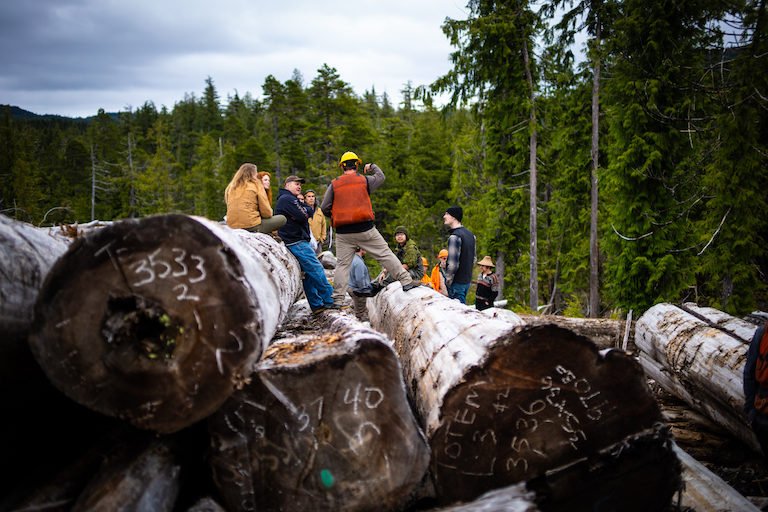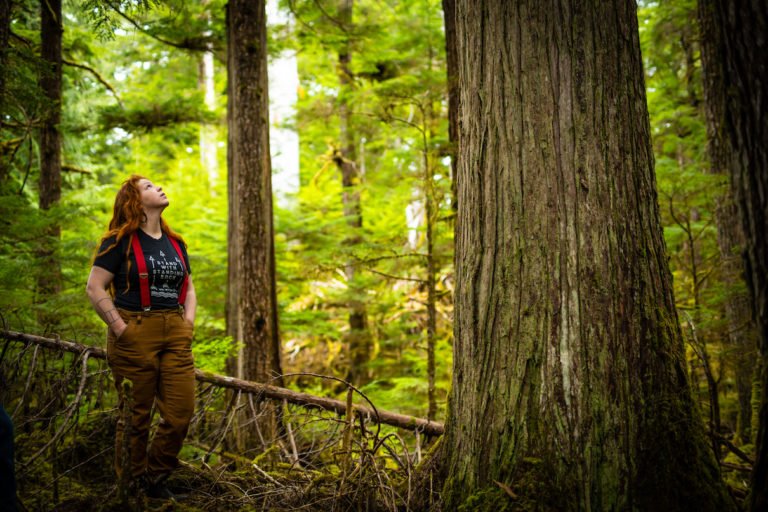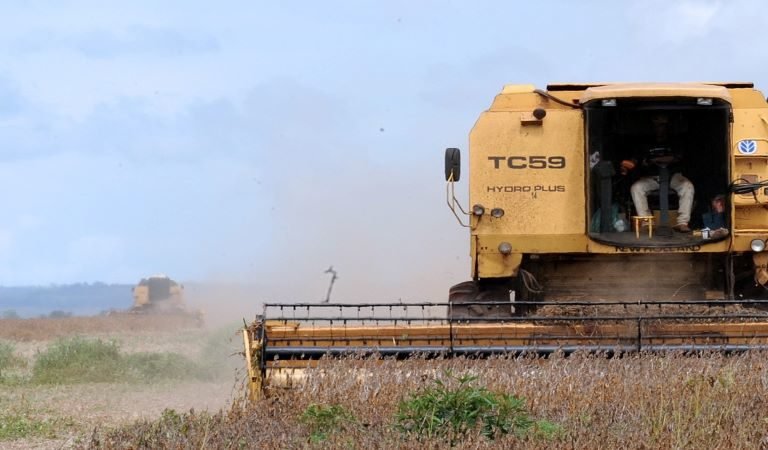- Access to ancient cedar trees for cultural purposes is key to Southeast Alaska native peoples, both for their heritage and community resilience.
- Carving and weaving traditions require straight-grained, slow-growth red and yellow cedar trees 450 years and older with few branches or defects. These rare forest giants are referred to as ‘monument trees,’ and many are contained in the Tongass National Forest.
- Despite its significance, the Tongass continues to be threatened by forest management pressures, climate change, and political shifts: more than 1 million acres of forest have clear-cut since it was declared a national forest.
- This article is a commentary. The views expressed are those of the author, not necessarily of Mongabay.
Despite heavy-duty rain gear and Xtra-tuff boots, I am soaked to the bone. But you can’t put money on a sunny day in the world’s largest temperate rainforest – the Tongass National Forest – even in Kéex’ Kwáan (Kake), considered to be the sunniest town in Southeast Alaska. I trudge onwards, thankful for the old growth cedar and spruce canopy above, doing its best to shield us from the downpour. Five Alaska native youth with a box of 6-inch cedar stecklings rambunctiously follow, working their way through the berry bushes in an attempt to lead the group.
The youth are crew members of a Native stewardship and conservation program called the Alaskan Youth Stewards (AYS); it is my third summer as their crew leader. Unlike me, raised in the boiling hot and humid summers of Georgia, the crew members have grown up in Kake and thrive in the chilly, wet forest conditions. Ethan, who’s taken the lead, points upwards to a giant cedar snag with the girth of a poker table. “Look!” A scar the width of two hands runs up the cedar’s trunk about 30 meters, narrowing to a point. The youth stare in collective silence up at the culturally-modified tree – a cedar tree from which bark has been harvested for Alaskan native cultural purposes. Perhaps it was one of their ancestors who harvested that strip of cedar bark hundreds of years ago.
Southeast Alaska, known for its jagged snow-covered peaks, salmon-filled waters, and old growth forests, is the original homeland of the Haida, Tsimshian, and Tlingit people. For approximately 10,000 years, Alaska Native tribes have stewarded the waters and lands of what is now called the Tongass National Forest, sustainably using forest and ocean resources for subsistence, cultural traditions, and art. Cedar trees and bark, used to create utilitarian and cultural items including totem poles, dugout canoes, paddles, woven hats and baskets, and regalia are especially significant forest resources. Carving and weaving traditions require straight-grained, slow-growth red and yellow cedar trees 450 years and older with few branches or defects. These rare forest giants are referred to as ‘monument trees.’
Use of cedar for cultural purposes is important to Southeast Alaska native people, both for their heritage and community resilience. Recent research highlights the significance of carving and weaving for Alaskan native people, including provision of essential cultural ecosystem services – benefits provided by nature that have cultural or spiritual significance. Research emphasizes the undeniable association between cedar carving/weaving and identity, physical and mental health, spirituality, and connection to nature for Alaskan native people. Additionally, the Tongass performs critical ecosystem services including global climate mitigation: it’s America’s largest carbon sink, absorbing and storing 44% of all carbon sequestered by United States national forests.

Despite its biocultural and environmental significance, the Tongass continues to be threatened by forest management pressures, climate change, and political shifts. Federal and public advocacy is essential to safeguard cultural forest resources to support native Alaskan lifeways.
Since the designation of 16.7 million acres of Southeast Alaska as the Tongass National Forest in 1907, logging industries have clear-cut more than 1 million acres of forest – about the size of the state of California! This extraction of forest resources has resulted in the removal of approximately half of the region’s old growth trees. Red cedar, being a highly valuable export, is more heavily targeted by domestic and international lumber markets. Furthermore, current United States Forest Service management practices prioritize even-age, young-growth forests, a conflicting growing strategy to the slow-growth requirements of monument trees.
In addition to logging pressures, the health and prevalence of yellow cedar is greatly threatened by climate change. As a result of rising global temperatures, the winter snowpack essential for insulating the shallow yellow cedar roots has become insufficient, causing the roots to freeze and leading to mass yellow cedar death. In 2007, scientists reported greater than 70% of the mature yellow cedar trees in the Tongass National Forest as dead.

Lastly, since governance of the Tongass National Forest rests in the hands of the United States federal government, it lies at the whims of political drama and turnover. In October 2019, former U.S. President Trump appealed the 2001 Roadless Rule, an agreement between Southeast Alaska native tribes and Congress, protecting huge spans of Tongass rainforest from road development and natural resource extraction. Even though President Biden reinstated the Roadless Rule in November of 2021, the events prove that long-term conservation of the forest is susceptible to the oscillations of federal administration cycles.
The pressures of logging, climate change, and political instability are all significant threats to the peoples and environments of the Tongass. Domestic and international advocacy is needed for the protection of Alaska native culture and global climate resilience. There are a number of actions that people can take to support the conservation of the Tongass and Alaska Native culture.
Firstly, the public must advocate for the support of the Southeast Alaska Sustainability Strategy, a collaborative effort between the U.S. Department of Agriculture agencies and Alaska native tribes to “help support a diverse economy, enhance community resilience, and conserve natural resources.” You can help by contacting your state senators and representatives to advocate for the agency’s efforts to conserve Southeast Alaska’s natural resources and Indigenous cultures and lifeways.

Secondly, you can assist the local efforts supporting Alaskan native cultural renaissance and biocultural conservation: Southeast community members and collaboratives such as the Sustainable Southeast Partnership work to protect monument trees, perpetuate Alaskan native culture, and increase access to cedar forest products for future generations. You can expand such efforts by donating to support Alaskan native stewardship, forest regeneration projects, and youth capacity-building programs including the Alaskan Youth Stewards, the Keex Kwaan Community Forest Partnership, and the Hoonah Native Forest Partnership.
Lastly, we all have a responsibility to be mindful consumers. Before purchasing lumber or forest products, research the wood’s origins and be aware of how consumer purchases may impact the culture and wellbeing of the people who live there.
Audrey Clavijo worked and lived in Kake, Alaska for three summers as the Kake AYS Coordinator and Crew Leader. She is currently a Masters student at Colorado State University in the Conservation Leadership program.










